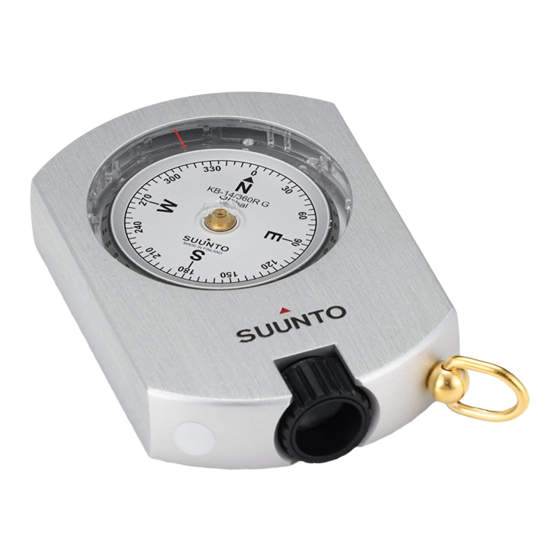
Advertisement
Advertisement
Table of Contents

Summary of Contents for Suunto KB Series
- Page 1 EN | FR | DE | ES | IT | FI | SV...
- Page 2 COPYRIGHT This publication and its contents are proprietary to Suunto Oy. Suunto, Wristop Computer, Suunto KB-series and their logos are registered or unregistered trademarks of Suunto Oy. All rights reserved. While we have taken great care to ensure that information contained in this documentation is both comprehensive and accurate, no warranty of accuracy is expressed or implied.
- Page 3 Suunto Kb-series USER'S GUIDE...
-
Page 4: Table Of Contents
TABLE OF CONTENTS USAGE ....................... 4 DETERMINING A LOCATION ................4 DECLINATION ....................5 ADJUSTABLE DECLINATION CORRECTION (KB-14D): PICK A SUITABLE TARGET ................6 DEVIATION (DIVERGENCE) ................9 INCLINATION - BALANCING ................9 ADJUSTING THE OPTICS ................9 CLEANING ....................... 10 WARRANTY ..................... -
Page 5: Usage
USAGE Keep both eyes open and aim with the compass so that the sighting line meets the target when viewing through the lens. In R-models the main scale indicates the reading to the target you are aiming at and the reversed scale indicates the reading from your target to the aimed location. -
Page 6: Declination
The cotangent table at the back of the compass used distance calculations and especially for determining locations when two landmarks appear in a very narrow angle. This situation is depicted on the same map. In this example the angle between the lighthouse and the sea mark is 20°. -
Page 7: Adjustable Declination Correction (Kb-14D): Pick A Suitable Target
ADJUSTABLE DECLINATION CORRECTION (KB-14D): PICK A SUITABLE TARGET Keep both eyes open and aim with the compass so that the fixed sighting line (the one without E/W indication) meets the target (when viewing through the lens). Please note that the fixed sighting line always indicates the bearing without hour declination correction. - Page 8 -10° = 1) = 2) -10° (West) (East)
- Page 9 ATTENTION! When using the maneuverable sighting line, always take the reading at the same place of the scale line, for instance, at the end of the scale line. Please note that the difference on the scale between the fixed and maneuverable sighting lines is about half of the adjusted declination correction.
-
Page 10: Deviation (Divergence)
DEVIATION (DIVERGENCE) Iron and metal objects near the compass, e.g. some watches or glasses with metal frames, may cause deviation. If possible, such objects should be removed from the immediate proximity of the compass. Massive iron constructions, such as buildings, engines and piers made of metal reinforced concrete, are also potential causes for deviation. -
Page 11: Cleaning
CLEANING Use only water and mild soap when cleaning the compass! Do not use detergents or solvents of any kind as these may damage the compass capsule. The models with adjustable optics can be cleaned internally by rinsing if the inner part of the compass is dirty or condensation has occurred.





Need help?
Do you have a question about the KB Series and is the answer not in the manual?
Questions and answers